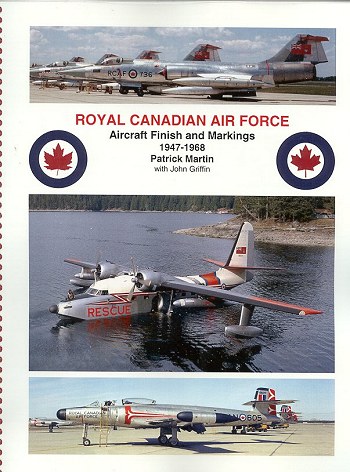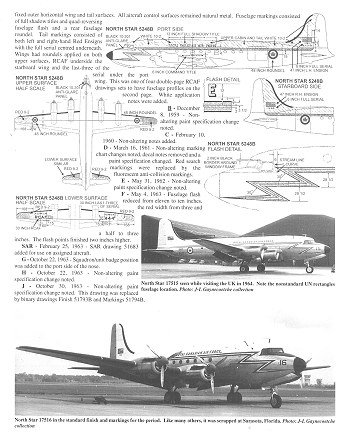 Pat Martin is well known amongst those really interested in
the more esoteric aspects of our hobby as providing excellent reference
books. His first two books were on USN and USAF tail codes. He then
produced a super book on Canadian Air Force markings for 1969 to the
present a few years ago. This particular book covers the Royal part of the
CAF from 1947 until 1968 when that part was dropped from the name.
Pat Martin is well known amongst those really interested in
the more esoteric aspects of our hobby as providing excellent reference
books. His first two books were on USN and USAF tail codes. He then
produced a super book on Canadian Air Force markings for 1969 to the
present a few years ago. This particular book covers the Royal part of the
CAF from 1947 until 1968 when that part was dropped from the name.
As with most of the world's air forces, this period of time
was one of a very large number of different types of aircraft as well as
the change from mostly reciprocating to turbine powered aircraft. As in the
switch from steam to diesel locomotives in the railroads, you could find
both types operating at the same time.
Pat's book is 288 pages, spiral bound with color on both
sides of the covers as well as an 8 page full color section. There are
several hundred well printed and clear black and white photos throughout
the book, the vast majority which are being published for the first time.
The book is broken down into six major sections: Intro,
Finish, Markings, Special Purpose Schemes, Aircraft Types, and Appendicies.
The Introduction includes phraseology, abbreviations,
acknowledgements and a section on how to use the book as well as background
on the official drawings used in the book. One should not skip this section
as it is invaluable to understanding the rest of the book.
Finish is dedicated to the basic overall color schemes used
during this period.
Markings covers standard placement of insignia, codes as
well as the proper sizing of these items.
The section on Special Purpose Schemes covers markings used
by SAR aircraft, display teams, trainers, UN aircraft and the like.
 By far the largest section of the book covers specific
aircraft and is listed alphabetically from Albatross to Yukon. Each
aircraft type has a brief history, RCAF units that flew the plane, and the
markings used during various times of its RCAF history. Serials of some
types are provided as well. Each section has the appropriate drawings
corresponding to the various eras in which the aircraft was in service.
By far the largest section of the book covers specific
aircraft and is listed alphabetically from Albatross to Yukon. Each
aircraft type has a brief history, RCAF units that flew the plane, and the
markings used during various times of its RCAF history. Serials of some
types are provided as well. Each section has the appropriate drawings
corresponding to the various eras in which the aircraft was in service.
The Appendices cover airframe serial allocations, drawing
numbers, and other miscellaneous information.
This isn't a book where one sits down and reads it from
front cover to back in a few hours. At least, it isn't really designed in
that manner. It is a reference book. After ingesting the basics on how the
system works, the reader then uses it to learn about the specific types in
which one is interested. I've had this book for several weeks and have read
a bit every day. I've still got lots to go.
It is a book that will be of particular interest to
modelers as it provides all the correct information on markings and camo
schemes. Those just like reading about aircraft of the period will also
find it a fascinating read as it covers classic aircraft of the time such
as Mustangs, Mitchells, Lancasters, Sabres and Canucks. And of course,
those who have an interest in the RCAF have to have this one on their
shelves. It is a book that I highly recommend, not only for the depth of
research that went into it, but because it is superbly formatted and well
written.
Review book courtesy of Pat Martin. Thank you for
your continued support. Here is a link to an
order form.
If you would like your product reviewed fairly and quickly by a
site that has well over 200,000 visitors a month, please contact
me or see other details in the Note to
Contributors.
 Pat Martin is well known amongst those really interested in
the more esoteric aspects of our hobby as providing excellent reference
books. His first two books were on USN and USAF tail codes. He then
produced a super book on Canadian Air Force markings for 1969 to the
present a few years ago. This particular book covers the Royal part of the
CAF from 1947 until 1968 when that part was dropped from the name.
Pat Martin is well known amongst those really interested in
the more esoteric aspects of our hobby as providing excellent reference
books. His first two books were on USN and USAF tail codes. He then
produced a super book on Canadian Air Force markings for 1969 to the
present a few years ago. This particular book covers the Royal part of the
CAF from 1947 until 1968 when that part was dropped from the name. By far the largest section of the book covers specific
aircraft and is listed alphabetically from Albatross to Yukon. Each
aircraft type has a brief history, RCAF units that flew the plane, and the
markings used during various times of its RCAF history. Serials of some
types are provided as well. Each section has the appropriate drawings
corresponding to the various eras in which the aircraft was in service.
By far the largest section of the book covers specific
aircraft and is listed alphabetically from Albatross to Yukon. Each
aircraft type has a brief history, RCAF units that flew the plane, and the
markings used during various times of its RCAF history. Serials of some
types are provided as well. Each section has the appropriate drawings
corresponding to the various eras in which the aircraft was in service.